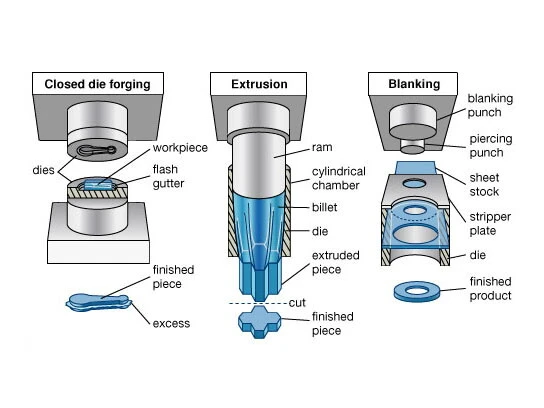Introduction to Die Forging
The importance of precision die forging lies in its ability to fabricate intricate shapes and high-accuracy forgings directly on specialized equipment. Take, for instance, precision die forging of bevel gears, where tooth profiles are formed without the need for additional cutting. This process achieves dimensional accuracies ranging from IT12 to IT15, with surface roughness values between 3.2 and 1.6 micrometers.

The precision die forging procedure involves several key steps:
Designing the forging process and auxiliary steps, such as flash cutting and deburring, along with determining heating methods and specifications.
Addressing surface defects on billets before forging.
Selecting appropriate billet sizes, qualities, and cutting methods.
Choosing suitable precision die forging equipment.
Determining lubrication, die cooling methods, and forging cooling specifications.
Establishing heat treatment methods for forgings and outlining technical and inspection requirements.
Precision die forging demands meticulous attention to various process requirements:
Preparation of billets involves strict quality control to ensure precise dimensions, flat end surfaces, and cleanliness free from defects like pits or scratches.
Billet heating aims for minimal oxidation to reduce scale formation.
The forging process, often involving multiple passes, achieves high dimensional accuracy and surface finish.
Intermediate cleaning steps are crucial to maintain surface quality between forging stages.
Proper lubrication ensures uniform deformation and optimal metal flow.
Precision die forging relies on equipment with high stiffness and accuracy, like crank presses or friction presses.
This advanced technique offers several distinctive features:
Accurate calculation and cutting of original blanks are essential to maintain dimensional tolerances.
Surface cleaning and oxide removal are critical to enhance forging quality.
Non-oxidizing heating minimizes scale formation, particularly in warm die forging.
Precision forging die chambers require high precision to ensure accuracy and efficient metal flow.
Lubrication and die cooling are vital for successful precision die forging.
The process is typically carried out on specialized equipment to meet stringent accuracy requirements.
Precision die forging represents a significant advancement, reducing metal wastage and machining time compared to traditional methods. However, its adoption necessitates careful consideration of economic factors and specific part requirements.

The precision die forging procedure involves several key steps:
Designing the forging process and auxiliary steps, such as flash cutting and deburring, along with determining heating methods and specifications.
Addressing surface defects on billets before forging.
Selecting appropriate billet sizes, qualities, and cutting methods.
Choosing suitable precision die forging equipment.
Determining lubrication, die cooling methods, and forging cooling specifications.
Establishing heat treatment methods for forgings and outlining technical and inspection requirements.
Precision die forging demands meticulous attention to various process requirements:
Preparation of billets involves strict quality control to ensure precise dimensions, flat end surfaces, and cleanliness free from defects like pits or scratches.
Billet heating aims for minimal oxidation to reduce scale formation.
The forging process, often involving multiple passes, achieves high dimensional accuracy and surface finish.
Intermediate cleaning steps are crucial to maintain surface quality between forging stages.
Proper lubrication ensures uniform deformation and optimal metal flow.
Precision die forging relies on equipment with high stiffness and accuracy, like crank presses or friction presses.
This advanced technique offers several distinctive features:
Accurate calculation and cutting of original blanks are essential to maintain dimensional tolerances.
Surface cleaning and oxide removal are critical to enhance forging quality.
Non-oxidizing heating minimizes scale formation, particularly in warm die forging.
Precision forging die chambers require high precision to ensure accuracy and efficient metal flow.
Lubrication and die cooling are vital for successful precision die forging.
The process is typically carried out on specialized equipment to meet stringent accuracy requirements.
Precision die forging represents a significant advancement, reducing metal wastage and machining time compared to traditional methods. However, its adoption necessitates careful consideration of economic factors and specific part requirements.

